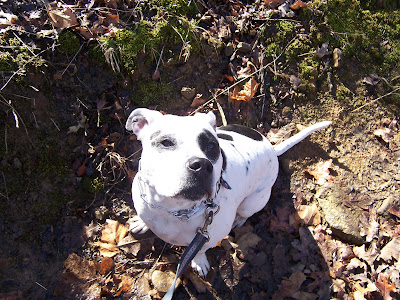I went to school for two years in Latimer County. Believe me when I say that the
Ouachitas have a very,
very special place in my heart shared only by my hometown and my honeymoon destination. Three days in Southeast Oklahoma cannot possibly be enough... but it was time well spent.
If you're heading from OKC to SE Oklahoma, do yourself a favor and take State Highway 270. I-40 is monotonous and Indian Nation Turnpike... you could probably sleep for miles and not miss anything. But 270 becomes a beautiful winding country highway through hills and forests and a variety of small towns with character. This is the way we go.
This was a birthday trip for me, so my husband baked a chocolate cake and packed it away in the car. (He's the best!) On the way down, we stopped at the darling
Bus Station Cafe in Seminole for a delicious burger and a perfectly cooked plate of catfish. Back in the car, we traveled on until we reached McAlester, where we visited
Whispering Meadows winery. The people there were incredibly nice - not only gave us a series of free tastings but also taught us some about wine and gave us a tour of their winery and it's quirky, gorgeous Victorian architecture. We left with a bottle of Deja Vu and In the Mood. To top it off, we learned that they have a sister winery close to our house! If we want one of their wines, they'll deliver it to Urban Wineworks for us. Neat, yes? Onward through Wilburton, my old college town. And my, oh my, did it change in the last... well, a lady shouldn't say how long ago she graduated from 2-year college! I'm still shocked by the number myself. Only one of my favorite diners were still there - and it had moved down the street a ways. We grabbed the flyer for it so we'd have the hours... good to know for later trips. And on to our destination,
Lake Wister State Park.
The folks in the park office were accomodating and we were in our cabin in no time. And, my friends, it was jaw-dropping amazing. The cabin itself was pretty nice, but the
VIEW was
incredible.
The cabin was on a peninsula in the middle of the lake, backing up to a little cliff, with a huge picture window from which we could see a little island and both the sunrise and sunset.
If all we did was sit and stare out the window all weekend, it would have been worth the money. We went to town for some groceries and found a little supermarket full of interesting taxidermy which included - if I remember correctly - a fox with sunglasses and a coyote with elongated fangs. We got some eggs and biscuits and hot links, then went back home for grilled dogs washed down with chocolate cake and Whispering Meadows' In the Mood. Healthy, no. But spoiled, yes we were!
The next day we drove down to the
Ouachita National Forest Recreation Area to hike the
Old Military Road Trail. It's 13 miles long, and travels 800 feet up Winding Stair Mountain to Talimena Drive Trail Head. From there it's all downhill. It was a nice hike - it went across little streams and creeks, through pine forest the entire way (and it was nice to see so much green in the winter). There were occassional glimpses through the woods of looming mountainsides and far-off views, and as we neared Talimena Drive we reached the old 1830s military road for which the hiking trail was named.
 |
THE Military Road. See it?
|
 |
| In a clearing with the mountains far in the background. |
We picnicked on
Talimena Drive and then bustled back just in time to make it to the car before sundown. And - my friends - I am not too man to admit that the hike kicked my booty a little more than I anticipated. But finish it we did. And to celebrate we did a little driving along Talimena, enjoying the overlooks, and made it back to the cabin by sunset to enjoy our view and have s'mores.
 |
| From Talimena Drive |
 |
| From Talimena Drive |
Sunday was less eventful, as we were both kinda tired and sore from our grand hiking adventure on the Old Military Road Trail. We made eggs and biscuits, packed up and drove around Lake Wister, getting in and out to explore as needs required. :)
 |
| We thought Lake Wister Dam looked a little like Gotham Jail... |
 |
| Last view of Wister! |
Back on Highway 270, heading for home, we stopped in Krebs for lunch... dare we
Pete's Place (also the makers of
Choc Beer)? Oh yes, we dared. I'd only been there once or twice before... if you've been, I'm sure you know why! But we were hoping for a lunch menu? There was none. It's the same as the dinner menu. They broke their rules by letting us split an order. Perhaps it isn't nice for me to tell you that, but it was nice of them to do it. We had the lasagna. Of course it was delicious. And between the two of us, we could not finish eating it. The one meal. (Which came with side orders of bread, salad, spaghetti, ravioli, and meatballs.) We took a box of spaghetti home. And thus ended our winter weekending in the Ouachitas.








.jpg)































